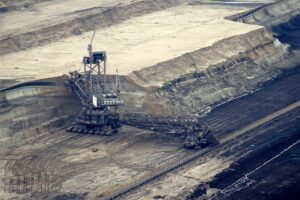- Journalize adjusting entries for the recording of depletion
By crediting the Accumulated Depletion account instead of the asset account (E.g. Coal Mine Assets), we continue to report the original cost of the entire natural resource on the financial statements. Thus, statement users can see the percentage of the resource that has been removed. To determine the total cost of the resource available, we combine this depletion cost with other extraction, mining, or removal costs. We can assign this total cost to either the cost of natural resources sold or the inventory of the natural resource still on hand. Thus, we could expense all, some, or none of the depletion and removal costs recognized in an accounting period, depending on the portion sold. If all of the resource is sold, we expense all of the depletion and removal costs. The cost of any portion not yet sold is part of the cost of inventory.
 mining company purchased a coal mine on Jan 1 20X5 for $2,800,000. The estimated capacity of the mine is 1,750,000 tons of coal, and the estimated salvage value is zero. The company incurred additional $50,000 on development of the mine for extraction purposes. They extracted 210,000 tons of coal from the mine up to Jan 31, 20X5, and sold all but 14,000 tons of the coal extracted from the mine, within Jan 20X5. Calculate the depletion expense on the mine for the month ending Jan 31, 20X5.
mining company purchased a coal mine on Jan 1 20X5 for $2,800,000. The estimated capacity of the mine is 1,750,000 tons of coal, and the estimated salvage value is zero. The company incurred additional $50,000 on development of the mine for extraction purposes. They extracted 210,000 tons of coal from the mine up to Jan 31, 20X5, and sold all but 14,000 tons of the coal extracted from the mine, within Jan 20X5. Calculate the depletion expense on the mine for the month ending Jan 31, 20X5.
Solution
Cost per Ton = 2,800,000 + 50,000 − 0
1,750,000
Cost per Ton = $1.62857
Total Depletion of Mine
= $1.62857 × 210,000
= $342,000
The mine will be stated at $2,508,000 (= 2,800,000 + 50,000 − 342,000) in the balance sheet on Jan 31, 20X5, but not all of the amount $342,000 will be recorded as depletion expense because the company had 14,000 tons of coal unsold at the end of the month. Here, the depletion expense will be calculated using the following formula:
Depletion Expense = Total Depletion of Mine − Depletion Related to Unsold Extract
Depletion Expense = $342,000 − $1.62857 × 14,000
Depletion Expense = $342,000 − $22,800
Depletion Expense = $319,200
The following list records the depletion expense and inventory on Jan 31, 20X5:
Coal Inventory 22,800
Depletion Expense 319,200
Coal Mine Assets 342,000